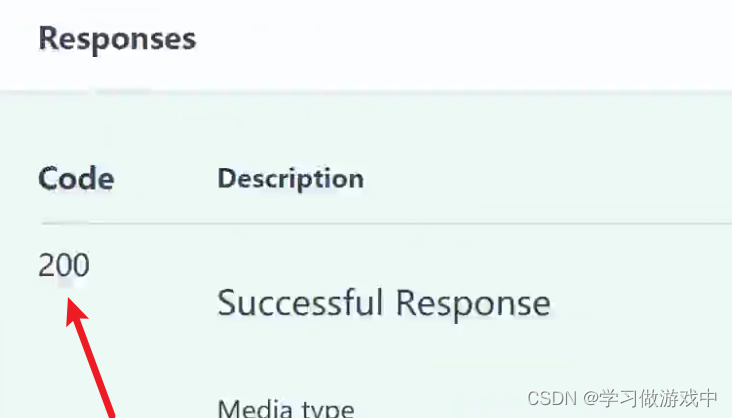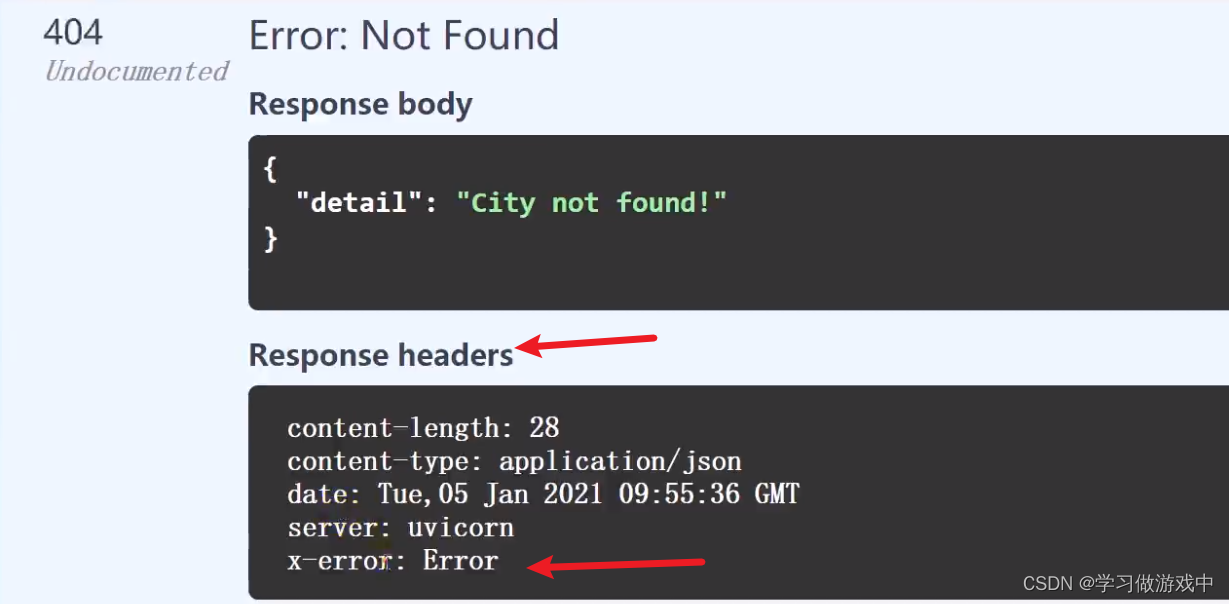- 1【微服务】Sentinel(流量控制)
- 2ucos 之系统启动 OSStart() 源码分析 3
- 3git生成SSH秘钥(git报错git@github.com: Permission denied (publickey). Could not read from remote repositor)_cat' 不是内部或外部命令,也不是可运行的程序 或批处理文件。
- 4【传统网络】以太网发包原理_ethernet接口没有发包计数
- 5#旭日X3派首百尝鲜# 【AI健身实体机】Arduino使用MAX30102人体心率血氧检测模块在X3派上位机上的显示_max30105 was not found. please check wiring/power.
- 6git clone指定分支_git clone 时指定分支
- 7git 错误error: failed to push some refs to
- 8面试字节跳动软件测试岗,收到offer后我却毫不犹豫拒绝了...._字节跳动 外包测试岗
- 9深度学习框架:TensorFlow与PyTorch实战
- 10Python中TensorFlow的长短期记忆神经网络(LSTM)、指数移动平均法预测股票市场和可视化
fastapi响应数据处理_fastapi中間件修改響應
赞
踩
密码使用场景
请求体和响应体的数据格式通常是不同的,如前端用户给后端服务器传递用户名、邮箱、手机号、密码等信息,后端给前端通常不会返回密码
EmailStr需要额外安装:pip install pydantic[email]
通过路径操作,path operation定义响应体的格式
请求体和响应体有关联的,可以通过定义共同的基类来节省代码
from typing import Optional, List from pydantic import BaseModel, EmailStr app04 = APIRouter() """Response Model 响应模型""" class UserIn(BaseModel): username: str password: str email: EmailStr mobile: str = "10086" address: str = None full_name: Optional[str] = None class UserOut(BaseModel): username: str email: EmailStr # 用 EmailStr 需要 pip install pydantic[email] mobile: str = "10086" address: str = None full_name: Optional[str] = None users = { "user01": {"username": "user01", "password": "123123", "email": "user01@example.com"}, "user02": {"username": "user02", "password": "123456", "email": "user02@example.com", "mobile": "110"} } @app04.post("/response_model/", response_model=UserOut, response_model_exclude_unset=True) async def response_model(user: UserIn): """response_model_exclude_unset=True表示默认值不包含在响应中,仅包含实际给的值,如果实际给的值与默认值相同也会包含在响应中""" print(user.password) # password不会被返回 # return user return users["user01"] @app04.post( "/response_model/attributes", response_model=UserOut, # response_model=Union[UserIn, UserOut], # 返回两者的并集字段 # response_model=List[UserOut], # 返回结果是多个包括userout类型的列表 response_model_include=["username", "email", "mobile"], # 需要在结果中包含的字段 response_model_exclude=["mobile"] # 需要排除的字段 ) async def response_model_attributes(user: UserIn): # del user.password # Union[UserIn, UserOut]后,删除password属性也能返回成功 return user # return [user, user]
- 1
- 2
- 3
- 4
- 5
- 6
- 7
- 8
- 9
- 10
- 11
- 12
- 13
- 14
- 15
- 16
- 17
- 18
- 19
- 20
- 21
- 22
- 23
- 24
- 25
- 26
- 27
- 28
- 29
- 30
- 31
- 32
- 33
- 34
- 35
- 36
- 37
- 38
- 39
- 40
- 41
- 42
- 43
- 44
- 45
- 46
- 47
- 48
- 49
- 50
- 51
表单数据处理
from fastapi import Form
@app04.post("/login/")
async def login(username: str = Form(...), password: str = Form(...)): # 定义表单类型,...为必填
"""用Form类需要pip install python-multipart; Form类的元数据和校验方法类似Body/Query/Path/Cookie"""
return {"username": username}
- 1
- 2
- 3
- 4
- 5
- 6
单文件,多文件上传
需要导入file和uploadfile,当使用file文件会用2进制形式写入内存,只适合小文件上传,文件太大会爆内存
@app04.post("/file")
# 如果要上传多个文件 files: List[bytes] = File(...)
async def file_(file: bytes = File(...)):
return {"file_size": len(file)}
- 1
- 2
- 3
- 4
在docs中可以看到定义了file类型后,请求就变为了form-data,在vue端编写请求的时候,可以参考

上传大文件需要使用uploadfile,使用UploadFile类的优势:
- 文件存储在内存中,使用的内存达到阈值后,将被保存在磁盘中
- 适合于图片、视频大文件
- 可以获取上传的文件的元数据,如文件名,创建时间等
- 有文件对象的异步接口,可以异步方式读取或更改文件
- 上传的文件是Python文件对象,可以使用write(), read(), seek(), close()操作
async def upload_files(files: List[UploadFile] = File(...)):
for file in files:
contents = await file.read()
print(contents)
return {"filename": files[0].filename, "content_type": files[0].content_type} # 返回第一个文件的数据
- 1
- 2
- 3
- 4
- 5
可以看到return输出的文件类型为application/vnd.openxmlformats-officedocument.spreadsheetml.sheet
在用python或其它语言时,实现下载excel功能或者是上传,要使用content_type定义类型
@app.get("/File")
async def get_file():
filepath = "./data/demo.xlsx"
filename = "demo.xlsx"
headers = {
"Content-Type": "application/vnd.openxmlformats-officedocument.spreadsheetml.sheet"
}
return FileResponse(filepath, filename=filename, headers=headers)
- 1
- 2
- 3
- 4
- 5
- 6
- 7
- 8
在终端看到的输出就是乱码
https://www.w3school.com.cn/media/media_mimeref.asp 可以看到其它常用格式的content_type
静态文件配置
静态文件也属于一种返回的形式,需要配置,在项目根路径新建static文件夹,之后在run.py即运行主文件中挂载,对于fastapi而言,static只是一个独立应用,与fastapi无关
app.mount(self,path,app,name) ,特别注意,只能挂在到FastAPI中不要挂到APIRouter中
from fastapi.staticfiles import StaticFiles
app.mount(path='/static', app=StaticFiles(directory='./static'), name='static')
- 1
- 2
路径操作配置
主要用于响应的描述,响应的数据格式,响应状态码等。
deprecated=True ,用于标注该接口已经废弃掉,但依然可以使用
tags=[‘’,‘’] ,接口的描述,可以添加多个,但是不建议,因为会很混乱
响应状态码
状态码可以在路径中的status_code中定义
from fastapi import status
@app04.post("/status_attribute", status_code=status.HTTP_200_OK)
async def status_attribute():
print(type(status.HTTP_200_OK)) # int类型 <class 'int'>
return {"返回的内容": "返回200状态码"}
- 1
- 2
- 3
- 4
- 5
如上,推荐使用status,不建议直接返回数字,因为语义化更明确。执行之后在docs中可以看到相应的code
fastapi应用的配置
在主文件中的FastAPI可以配置应用,title标题,description简介,version版本号,docs_url接口测试地址(默认是/docs),redoc_url(不能操作,可以给用户参考用,默认/redocs)
错误处理(不常用)
通过 from fastapi import HTTPException 捕获错误
if判断,满足条件后,raise抛出raise HTTPException(status_code=404, detail="City not found!", headers={"X-Error": "Error"}),headers为在response headers中插入值

想所有应用都用自定义的错误相应,就要在主文件run.py中配置
from fastapi.exceptions import RequestValidationError # 请求错误校验处理
from fastapi.responses import PlainTextResponse # 文本形式返回response
from fastapi import HTTPException
from starlette.exceptions import HTTPException as StarletteHTTPException # fastapi建立在starlette基础之上,所以与上一项的导入相同
- 1
- 2
- 3
- 4
重写http异常处理,其中request必须有,exc是错误
@app.exception_handler(StarletteHTTPException) # 重写HTTPException异常处理器,把原来的错误信息从json改为文本形式
async def http_exception_handler(request, exc):
return PlainTextResponse(str(exc.detail), status_code=exc.status_code)
- 1
- 2
- 3
PlainTextResponse的作用是:返回一些纯文本数据
重写请求验证的错误处理
@app.exception_handler(RequestValidationError)
async def validation_exception_handler(request, exc):
return PlainTextResponse(str(exc), status_code=400)
- 1
- 2
- 3
新建路由,验证错误处理
@app04.get("/http_exception/{city_id}")
async def override_http_exception(city_id: int):
if city_id == 1:
raise HTTPException(status_code=418, detail="Nope! I don't like 1.")
return {"city_id": city_id}
- 1
- 2
- 3
- 4
- 5



